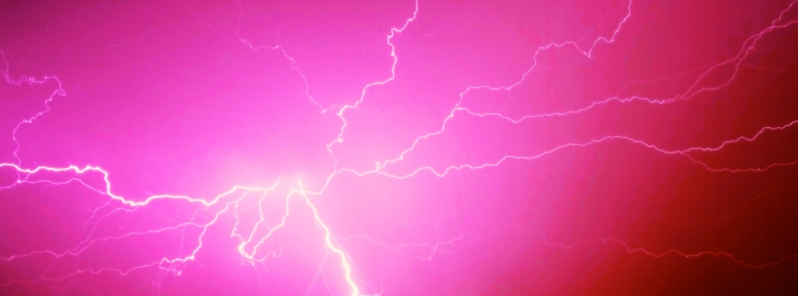Scientists find ‘superbolts’ flashing 1 000 brighter than normal lightning

Two new studies show that the brightest lightning events on Earth called "superbolts" can be more than 1 000 times brighter than normal lightning flashes. The findings could help scientists understand these mysterious flashes better, improving safety efforts and advisories.
"One lightning stroke even exceeded 3 terawatts of power–thousands of times stronger than ordinary lightning detected from space," said lead author Michael Peterson, a remote-sensing scientist at Los Alamos National Laboratory.
"Understanding these extreme events is important because it tells us what lightning is capable of," he added.
Peterson and his colleague Erin Lay analyzed data collected by NASA's Geostationary Lightning Mapper, a detector strapped to weather satellites sent into orbit to monitor and record lightning flashes over the Americas every two milliseconds.
The researchers combed two years of data for lightning strikes that flashed 100 times brighter than a normal bolt and discovered about two million events strong enough to be called a superbolt– about one in every 300 lightning events.
The brightest cases were concentrated in the central United States and in the Rió de La Plata Basin, which spans Uruguay, Paraguay, and parts of Argentina and Brazil.
However, the GLM detector might not have caught every single superbolt. Although the satellites are mounted on the Americas, from Alaska in the north to Argentina's southern tip, GLM measures the most powerful lightning bolts if they are shorter than 2 milliseconds.
"Using total energy to screen for the brightest lightning cases will miss short-duration yet extremely powerful optical pulses," the authors wrote.

There was a significant overlap with superbolts identified by Los Alamos researchers in the second study.
In this paper, the researchers studied 12 years of data from another satellite and counted lightning strikes as superbolts if they generated 100 gigawatts of power.
The papers addressed an ongoing debate among researchers about how these lightning flashes originate, and propose that superbolts usually result from rare, positively charged cloud-to-ground events, rather than the more usual negatively charged cloud-to-ground events characteristic of typical lightning.
The results also showed that superbolts often happen over the ocean and spark form megaflashes, which stretched hundreds of miles horizontally from tip to tail.
Image credit: Michael Peterson/Los Alamos National Laboratory
"Oceanic storm systems, particularly during the winter, and especially those located around Japan are shown to produce these intense superbolts," the researchers wrote.
Superbolts were first reported in 1977 based on optical brightness measurements by the Vela satellite. The phenomenon was initially described as lightning flashes that are 100 times brighter than normal lightning.
However, since then, scientists have debated whether these observations represent phenomena distinct from normal lightning. The viewing angle of a satellite, for instance, could affect the observed brightness of a lightning event.
"When you see a lightning flash from space, it will look a lot dimmer than if you were to see it from ground level because the clouds block some of the light," Peterson explained.
References
"Geostationary Lightning Mapper (GLM) Observations of the Brightest Lightning in the Americas" – Peterson, M. & Lay, E. – American Geophysical Union – DOI: 10.1029/2020JD033378
Abstract
Two years of Geostationary Lightning Mapper (GLM) science data are used to document the brightest lighting flashes observed on the Americas continent. The most radiant optical lightning emissions – termed “superbolts” – were first identified by the Vela satellite constellation in the 1970s (Turman, 1977) and are defined in terms of peak optical power. GLM is an integrating sensor that, instead, measures the total optical energy from a lightning pulse. While GLM might not correctly classify short-duration energetic superbolts, its top lightning cases certainly fall in the superbolt category, and the wealth of GLM measurements over its stationary hemispheric field of view provide an unmatched sample of extraordinarily bright lightning. While radiant bolts in excess of 100x the optical energy of typical lightning are ubiquitous across the Americas and result from many types of lightning processes, we find the most radiant cases (>1000x) are concentrated in the central United States and in the La Plata basin in South America. Coincident Earth Networks Global Lightning Network (ENGLN) observations reveal that these extremely bright emissions usually result from +CG strokes with high peak currents in long horizontal flashes outside of the convective core. Single cases of these megaflashes might produce multiple superbolts over their durations.
"Revisiting the Detection of Optical Lightning Superbolts" – Peterson, M. & Kirkland, M. W. – American Geophysical Union – DOI: 10.1029/2020JD033377
Abstract
This study uses Fast On-Orbit Detection of Transient Events (FORTE) satellite observations to identify superbolt-class optical lightning events and evaluate their origins. Superbolts have been defined by Turman (1977) as lightning pulses whose peak optical power exceeds 1011 W. However, it has been unclear whether superbolts resulted from particular types of high-energy lightning process or whether they were the result of measurement bias. In the latter case, any decently-bright lightning process could be recorded as a superbolt if the sensor had a particularly clear sight line to the hot channel without thick clouds diluting the optical signals. Our 12-year analysis of FORTE superbolt detections indicates that the lower optical superbolt energy range (~100 GW) is dominated by normal lightning, but brighter cases are predominantly strong +CG strokes that originate from specific types of storms. Oceanic storm systems, particularly during the winter, and especially those located around Japan are shown to produce these intense superbolts. We suggest that some optical superbolts result from favorable viewing conditions and would not be identified as such by another instrument located elsewhere, and that others are associated with a unique set of physics that may merit the “superbolt” distinction.
Featured image credit: ignacio sottano/Pexels

Commenting rules and guidelines
We value the thoughts and opinions of our readers and welcome healthy discussions on our website. In order to maintain a respectful and positive community, we ask that all commenters follow these rules.